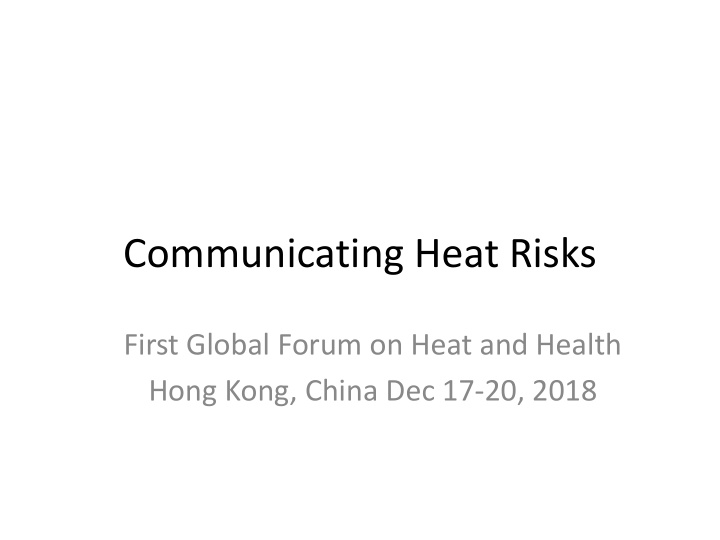



Communicating Heat Risks First Global Forum on Heat and Health Hong Kong, China Dec 17-20, 2018
Why this 1 st Forum has a risk communication focus Communication is regularly identified as the biggest gap and failure in efforts to protect health- including health in heat emergencies. Early planning is essential for effective risk communication: we have a unique opportunity here to identify gaps/problems and consider solutions, e.g. key messages, good practices Everyone thinks they know how to communicate- very few do it well
What i t is ‘ s ‘Risk C Com ommunicati tion’? ’? Why y doe oes i s it t mat atte ter? • A dialogue: it is real-time exchange of information, advice and opinions between experts, community leaders or officials and the people at risk. • A catalyst for behaviour change: effective risk communication allows people at risk to understand and adopt protective behaviours. • An educative process for authorities: enabling authorities and experts to listen to and address the concerns and needs of people at risk so that the advice provided is relevant, trusted and acceptable. • A process that must start BEFORE an emergency with good planning- for example in setting ‘tipping’ points for issuing warnings
Why doe oes s risk c com ommunicati tion fail? It is often applied poorly or too late, due to a range of factors including: • lack of preparation, • limited capacity, • lack of funding, • lack of recognition that it is an essential part of an effective response. • This forum is crucial for making sure that DOES NOT happen in heat health emergencies. This is the opportunity to get ahead of the crisis, work with the policymakers, plan the messages, identify the risk groups and what channels they use and involve them in your planning.
Why is communicating heat risk a challenge? • Invisible: Not a hard hazard. Something ‘everyday’…therefore not seen as a threat • Personal: everyone is affected differently • Occurs over different timescales • Has different cultural impacts: e.g.a rise in temperature may be welcomed but stimulate more dangerous behaviours in traditionally cool climates
State of Play • Is there global awareness that this is a serious problem? Promising sign: The Lancet Countdown press release- strong media pickup ‘Extreme heat damaging our health and livelihoods and threatening to overwhelm hospitals around the world’ • Research from 27 global institutions published in The Lancet says our vulnerability to heat is unacceptably high and rising in all regions of the world. • Outdoor workers, people with underlying health conditions and the urban elderly especially at risk. A good start: shows strong interest in the topic BUT needs • to be sustained. One aim of discussions should be to develop a long term media plan
Some Advocacy… According to the petition, a worker heat stress standard is necessary because global warming has caused more days of extreme heat, and each summer is producing record-breaking temperatures, with 85 "deadly heat" days projected for the southeast region by the year 2100. The Bureau of Labor Statistics reported that from 1992 through 2016, 783 U.S. workers died from excessive heat, and more than 69,000 were injured by high temperatures.
Risk messages must be actionable and targeted to the people/groups at risk but… There are very big gaps in what we know about public perceptions of heat as a health risk and whether or not people take action A recent UK assessment found that while perception of heat as a health risk is improving, individuals may not identify as being at risk. Many people in cooler climates welcome the warmer weather. ‘It’s a problem -but not for me’ -People e.g. frail older people may not be able to take action -People may not be aware they are at risk: -Outdoor workers (and their employers) -People in the armed forces/ disciplined services/first responders ‘
Wh Who c commu mmunicates? Should identify and use most trusted channels/ spokespeople Who and what are these? • In most health communications scientists/ technical people are the most trusted communicators • Meteorologists/ met broadcasters • Healthcare advisors: doctors/nurses • Teachers- trusted and have access to an excellent communications channel: your children • Public heath specialists • But in reality it is the policymakers, politicians, civic leaders who often take the lead. All need to be involved in planning and preparation, do regular media training and simulations if they are to get it right
Forum Day 3: Risk Communications Participate actively in the five opportunities to learn more and help identify how to communicate heat risks effectively and advocate for heat action! 1. Keynote: Risk Communication 2. Expert Panel 3. Master Class: sharing good practices 4. Simulation Exercise of a Heat Emergency 5. Great Debate – understanding different perspectives
Recommend
More recommend